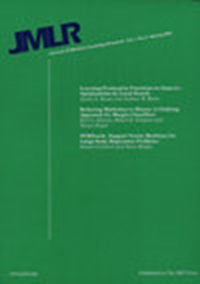一种用于凸优化的python嵌入式建模语言。
IF 5.2
3区 计算机科学
Q1 AUTOMATION & CONTROL SYSTEMS
Journal of Machine Learning Research
Pub Date : 2016-04-01
引用次数: 0
摘要
CVXPY是一种特定于领域的语言,用于在Python中嵌入凸优化。它允许用户用遵循数学的自然语法来表达凸优化问题,而不是用求解器所要求的限制性标准形式。CVXPY可以很容易地将凸优化与Python的高级特性(如并行性和面向对象设计)结合起来。CVXPY在GPL许可下可在http://www.cvxpy.org/获得,以及文档和示例。本文章由计算机程序翻译,如有差异,请以英文原文为准。
CVXPY: A Python-Embedded Modeling Language for Convex Optimization.
CVXPY is a domain-specific language for convex optimization embedded in Python. It allows the user to express convex optimization problems in a natural syntax that follows the math, rather than in the restrictive standard form required by solvers. CVXPY makes it easy to combine convex optimization with high-level features of Python such as parallelism and object-oriented design. CVXPY is available at http://www.cvxpy.org/ under the GPL license, along with documentation and examples.
求助全文
通过发布文献求助,成功后即可免费获取论文全文。
去求助
来源期刊

Journal of Machine Learning Research
工程技术-计算机:人工智能
CiteScore
18.80
自引率
0.00%
发文量
2
审稿时长
3 months
期刊介绍:
The Journal of Machine Learning Research (JMLR) provides an international forum for the electronic and paper publication of high-quality scholarly articles in all areas of machine learning. All published papers are freely available online.
JMLR has a commitment to rigorous yet rapid reviewing.
JMLR seeks previously unpublished papers on machine learning that contain:
new principled algorithms with sound empirical validation, and with justification of theoretical, psychological, or biological nature;
experimental and/or theoretical studies yielding new insight into the design and behavior of learning in intelligent systems;
accounts of applications of existing techniques that shed light on the strengths and weaknesses of the methods;
formalization of new learning tasks (e.g., in the context of new applications) and of methods for assessing performance on those tasks;
development of new analytical frameworks that advance theoretical studies of practical learning methods;
computational models of data from natural learning systems at the behavioral or neural level; or extremely well-written surveys of existing work.
 求助内容:
求助内容: 应助结果提醒方式:
应助结果提醒方式:


